|
American
Goldfinch / Chardonneret jaune (Spinus tristis) |
 |
Introductory notes:
Male and female American Goldfinches can be readily distinguished while in alternate plumage (roughly March or April to August or September), but differ more subtly in fall and winter. Ageing is simple in some cases, but can be complicated by unusually prolonged molt periods, which allow individuals of the same age and sex to have quite varying appearances at any given time. |
QUICK TIPS:
| 1) Look
at the wing in good light - on AHY/ASY males it is nearly uniformly black; on
AHY/ASY females it is nearly uniformly dark brown to dull blackish; on HY/SY males it is mostly dark
brown with contrastingly blackish greater coverts; on HY/SY
females it is brown with contrastingly dark brown greater coverts
2)
Examine the shape of the outer rectrices - most
goldfinches have somewhat intermediate rectrices, but those that are particularly broad and somewhat rounded are indicative of AHY/ASY
birds, while distinctly narrow and tapered rectrices are indicative of HY/SY birds
3)
Consider the colour of the outer rectrices - on
AHY/ASY males there is a sharp and abrupt contrast
between black and white; on HY/SY males they are
dark brown to blackish with fairly distinct whitish
patches; on AHY/ASY females they are dark brown
with distinct whitish patches; on HY/SY females
they are usually grayish-brown with indistinct pale
patches |
Species account updated January 2011 |
Ageing and sexing overview:
Ageing and sexing details:
|
JAN - JUL: after-second-year
male |
In alternate plumage, males are readily recognizable by their boldly contrasting black and yellow plumage, but wings and tail need to be considered for ageing, as SY and ASY birds show relatively subtle differences not usually visible on perched birds.
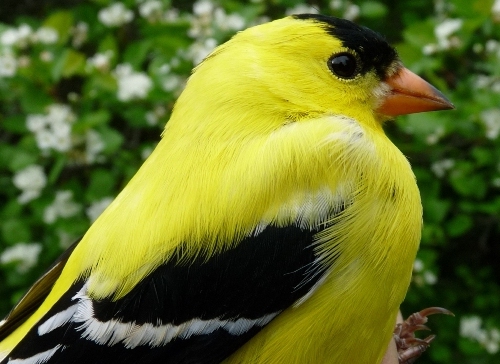
A typical ASY male, entirely yellow, black, and white.
Photo by Marcel Gahbauer, McGill Bird Observatory (QC), May 2010
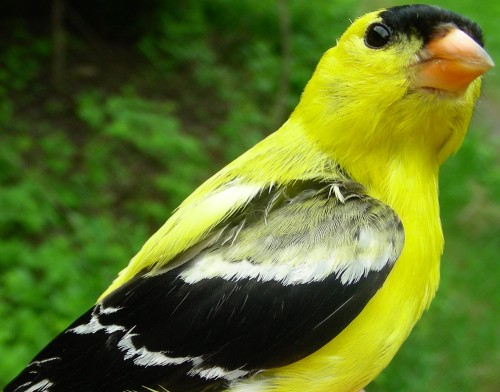
A slightly paler individual, especially on the lesser and median coverts which are more
whitish than the usual yellow.
Photo by Marie-Anne Hudson, McGill Bird Observatory (QC), May 2008
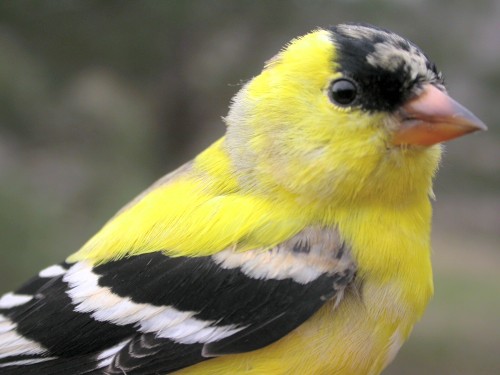
An ASY male a bit earlier in its prealternate molt, with pale patches remaining on the crown,
nape, back, and breast, contrasting with the fresh black and yellow alternate plumage.
Photo by Marcel Gahbauer, McGill Bird Observatory (QC), May 2005
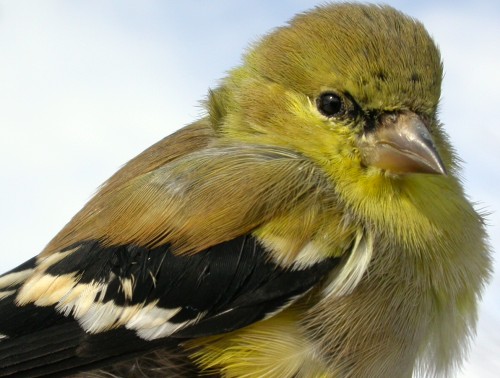
An ASY male in early spring, having only just started its prealternate molt, with a few
black feathers appearing in the face.
Photo by Marcel Gahbauer, McGill Bird Observatory (QC),
April 2005
After-second-year males generally have uniformly black primaries, secondaries, greater coverts, and primary coverts, although the primary coverts are sometimes a bit faded, giving the appearance of a molt limit.
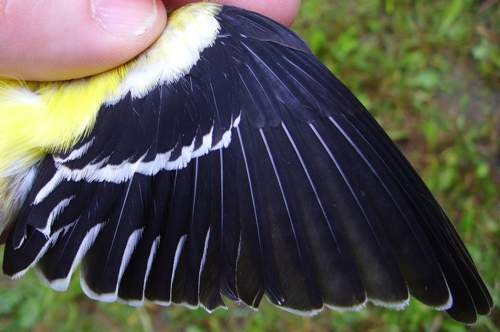
A typical ASY male wing, with solid black across the primaries, secondaries,
primary coverts, and greater coverts.
Photo by Peter Pyle, Merry Lea (IN), May 2007
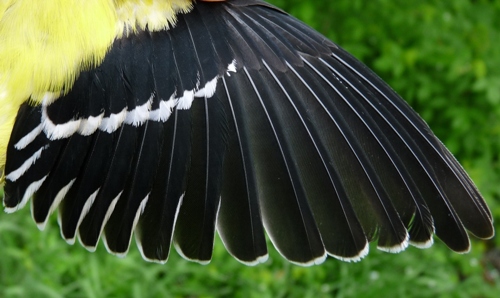
A variant in which the primary coverts (and to some extent the primaries) are a bit paler
than the greater coverts and secondaries. This pattern is quite similar to that seen on
SY males, though the ASY birds tend to be more solidly black on the inner wing.
Photo by Marcel Gahbauer, McGill Bird Observatory (QC), May 2010
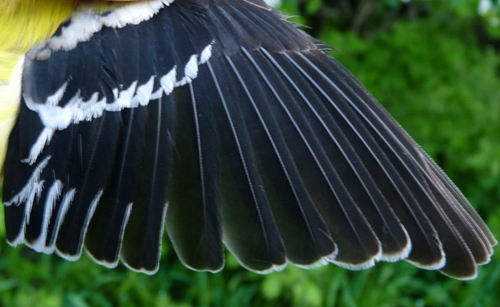
Another known ASY male (by recapture) showing somewhat paler primary coverts and
primaries in comparison with the greater coverts and secondaries. In this case even the
inner wing is somewhat dull, and would not be reliably separable from an SY male.
Photo by Marcel Gahbauer, McGill Bird Observatory (QC), May 2010
Most ASY males have large and distinct white patches on
the rectrices contrasting with an otherwise black tail. Although rectrix shape varies relatively little by age, it is on average somewhat broader and more rounded on ASY goldfinches.
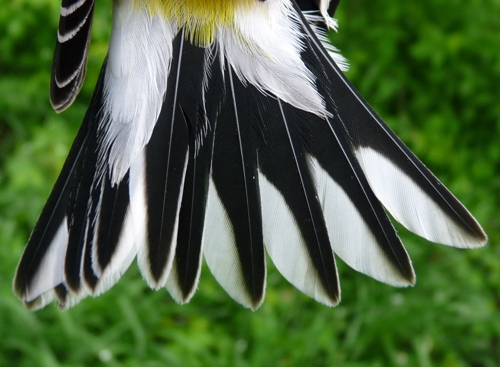
A typical ASY male tail, with glossy black contrasting with large and distinct white patches.
Photo by Marcel Gahbauer, McGill Bird Observatory (QC), May 2010
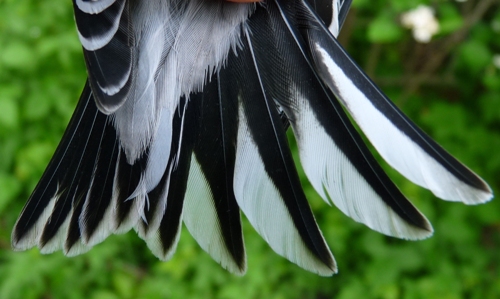
An ASY male with unusually long white patches on the outer rectrices.
Photo by Marcel Gahbauer, McGill Bird Observatory (QC), May 2010
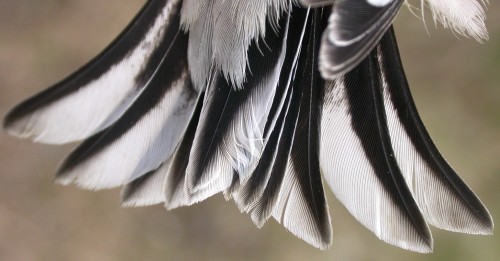
An ASY male with the white patches grading to gray a bit toward the tips, as seen
more commonly on SY goldfinches, but note that the white patches remain extensive
and the shape of the rectrices is similar to the other examples above.
Photo by Marcel Gahbauer, McGill Bird Observatory (QC), May 2005
RETURN TO AGE/SEX
OVERVIEW
|
JAN - JUL: after-second-year
female |
In alternate plumage, female American Goldfinches are readily distinguished from males by their duller plumage and lack of a black cap. In basic plumage, females are more similar to males, but they tend to be paler, with less yellow and more gray. In both plumages, age is difficult to assess without looking at the open wing and tail
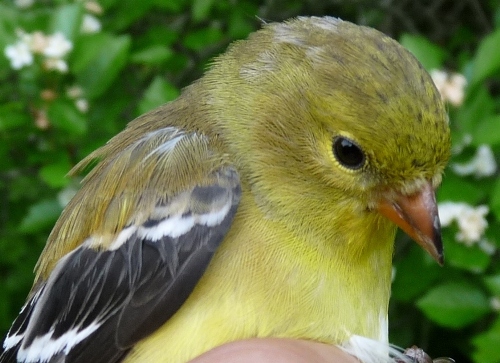
A typical ASY female in alternate plumage, much duller overall than ASY males.
Photo by Marcel Gahbauer, McGill Bird Observatory (QC), May 2010
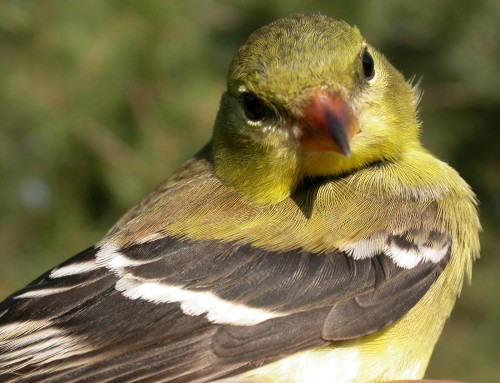
Another ASY female, highlighting the brownish back (compared to yellow on males) and
dark brown wings (compared to black on males).
Photo by Marcel Gahbauer, McGill Bird Observatory (QC), April 2005
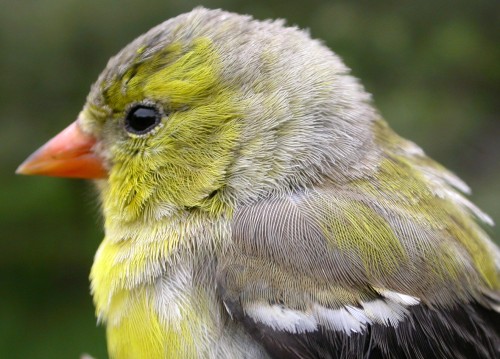
An ASY female relatively early in the prealternate molt, with some yellow plumage starting to
appear on the breast, face, and back, but the more grayish basic plumage still dominating.
Photo by Marcel Gahbauer, McGill Bird Observatory (QC), April 2005
The colour of the wing is fairly uniform on ASY females, but not nearly as dark as on
ASY males.
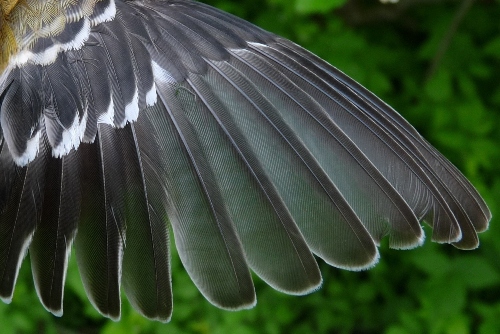
A typical ASY female wing, uniformly dark, but still distinctly paler than the glossy black
typical of ASY male wings.
Photo by Marcel Gahbauer, McGill Bird Observatory (QC), May 2010
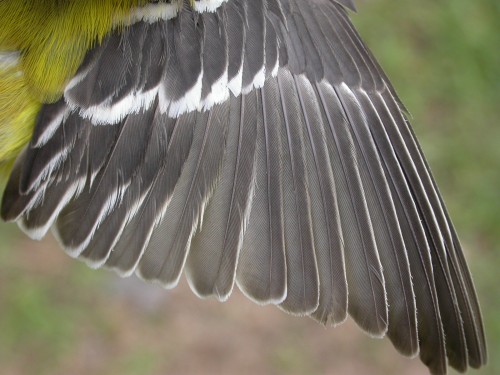
Another ASY female wing, this time showing a slight contrast between the greater coverts
and primary coverts (similar to the pattern in some ASY males), but still darker and
more uniform overall than would be expected on SY females.
Photo by Marcel Gahbauer, McGill Bird Observatory (QC), April 2005

A somewhat paler ASY female wing, but again very uniform in appearance.
Photo by Peter Pyle, Merry Lea (IN), May 2005
ASY females have relatively dark rectrices with moderate to large and usually distinct white patches. On average, the outer rectrices are broader and rounder than those of SY goldfinches, but there are a fair number of intermediates that are difficult to classify by shape..
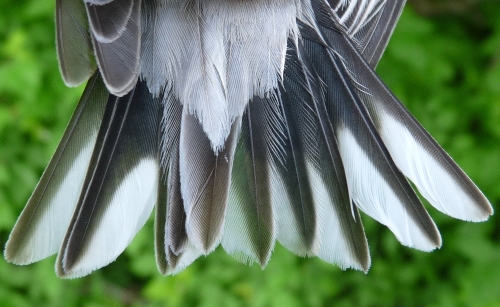
A fairly typical ASY female tail, with relatively broad rectrices that are dark but not black,
and have contrasting large and distinct white patches.
Photo by Marcel Gahbauer, McGill Bird Observatory (QC), May 2010
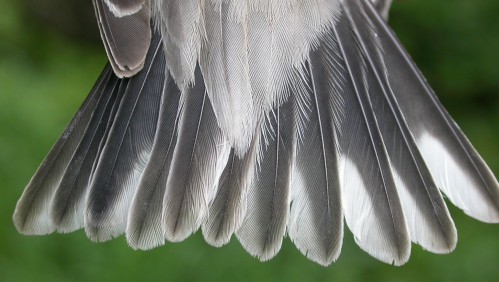
A somewhat paler ASY female tail, with the white patches a bit smaller, and fading
to gray near the tip.
Photo by Marcel Gahbauer, McGill Bird Observatory (QC), May 2006
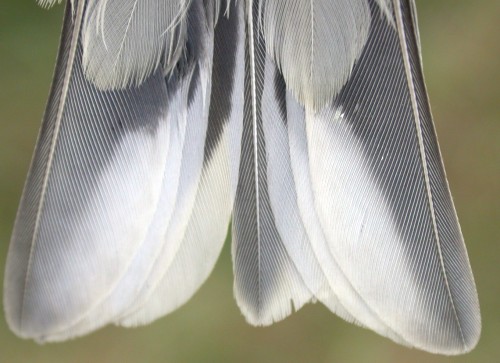
A view of the underside of an ASY female tail, highlighting the broad and rounded
shape of the rectrices, as well as the typical dark/white contrast.
Photo by Marcel Gahbauer, McGill Bird Observatory (QC), April 2005
RETURN TO AGE/SEX
OVERVIEW
|
JAN - JUL: second-year
male |
SY males are very similar in appearance to ASY males, and usually can be distinguished only with a good look at the wing and tail.
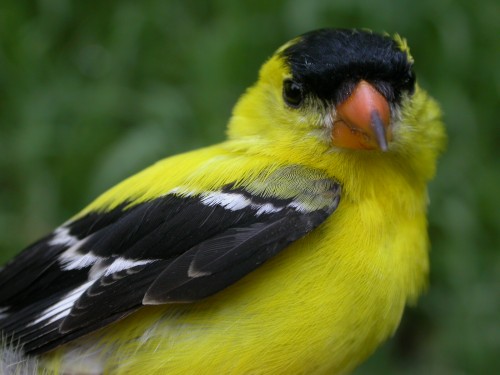
A rather dark SY male, which would be difficult to distinguish from ASY males from this
view, although the pale tips to the alula and primary coverts provide possible clues.
Photo by Marcel Gahbauer, McGill Bird Observatory (QC), May 2006
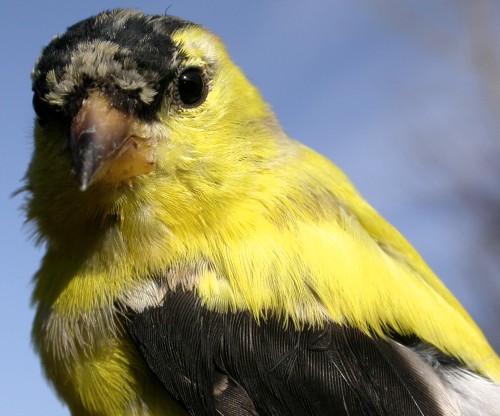
An SY male transitioning from basic to alternate plumage, still with some gray basic
feathers on the crown, but with the back largely replaced already.
Photo by Marcel Gahbauer, McGill Bird Observatory (QC), May 2005
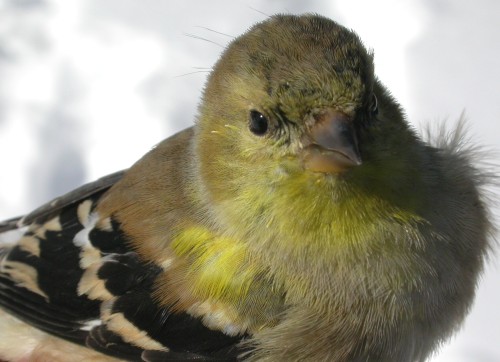
A basic plumage SY male, with only a few yellow feathers on the throat and shoulder,
and a few black feathers on the crown, but note the blackish wings.
Photo by Marcel Gahbauer, McGill Bird Observatory (QC), April 2005
SY goldfinches typically have a molt limit among the greater coverts or between the greater coverts and primary coverts. However, since the primary coverts may also be paler than the greater coverts on some ASY males, there are intermediates that can be difficult to age with certainty based on the wing. Generally the greater coverts and secondaries are less dark on SY males than ASY males, but this too is variable.
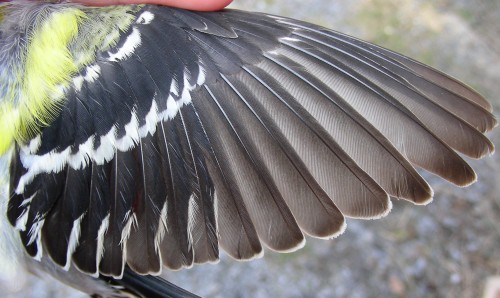
An example showing a relatively subtle molt limit between the greater coverts and primary
coverts, and dark but not fully black inner wing. This is similar in appearance to some paler
ASY males, and should not be aged without consulting the tail. Note that the lesser coverts
are mottled, rather than solid yellow,
which is also a pattern more commonly seen on SY males,
but can occur on ASY males too, especially prior to completion of the prealternate molt.
Photo by Marie-Anne Hudson, McGill Bird Observatory (QC), April 2008
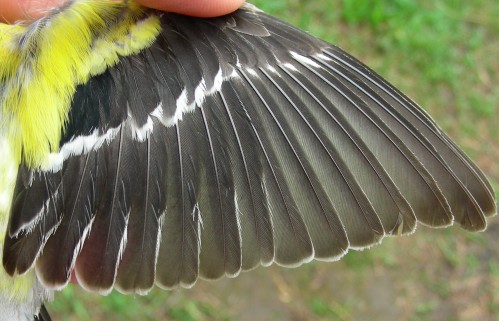
A somewhat more distinct SY male wing, less black overall, and with a clear contrast
showing between the two inner greater coverts that have been replaced during
the prealternate molt, compared with the older and duller adjacent feathers.
Photo by Marie-Anne Hudson, McGill Bird Observatory (QC), May 2008
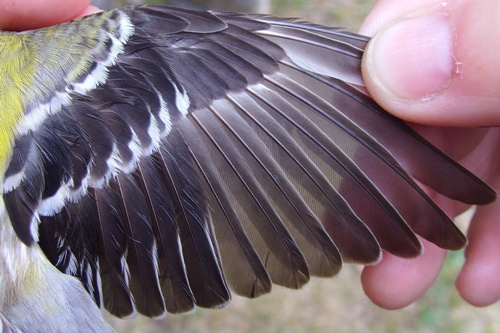
A similar example to the previous one, with the lone alternate greater covert contrasting
visibly with surrounding feathers, and a molt limit between the greater and primary coverts.
Photo by Peter Pyle, Merry Lea (IN), May 2007
Both shape and colour of the rectrices can be helpful with ageing. SY males tend to have blackish tails with moderate to large white patches, but unlike on most ASY males, these spots almost always fade to gray near the tip. While rectrix shape is quite variable on goldfinches and there are many intermediates, those that are particularly narrow and tapered are also indicative of SY birds.
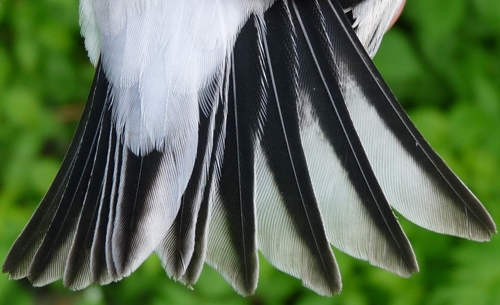
A relatively dark SY tail, with extensive white patches and intermediately shaped
rectrices, but note that the white patches are all distinctly faded at the edges.
Photo by Marcel Gahbauer, McGill Bird Observatory (QC), May 2010
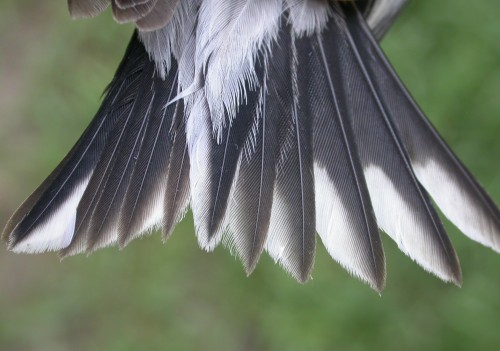
A more typical SY male tail, with dark but not black rectrices that are relatively narrow
and pointed, and moderately large but indistinctly defined white patches.
Photo by Marcel Gahbauer, McGill Bird Observatory (QC), May 2006
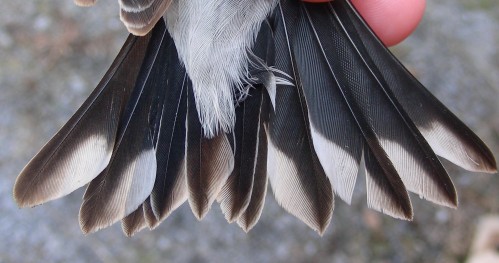
A somewhat atypical SY male tail, in that the white patches are smaller than average,
while the rectrices are relatively broad.
Photo by Marie-Anne Hudson, McGill Bird Observatory (QC), April 2008
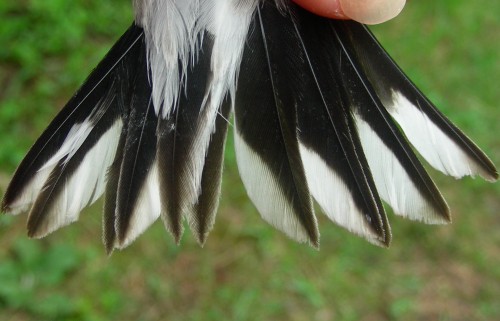
Another fairly dark but overall typical SY male tail with respect to rectric shape and
the extent and pattern of the white patches.
Photo by Marie-Anne Hudson, McGill Bird Observatory (QC), May 2008
RETURN TO AGE/SEX
OVERVIEW
|
JAN - JUL: second-year
female |
Second-year
females have the dullest apperance overall, with their brown wings often
showing relatively little contrast (in basic plumage) with the back compared to other
ages/sexes.
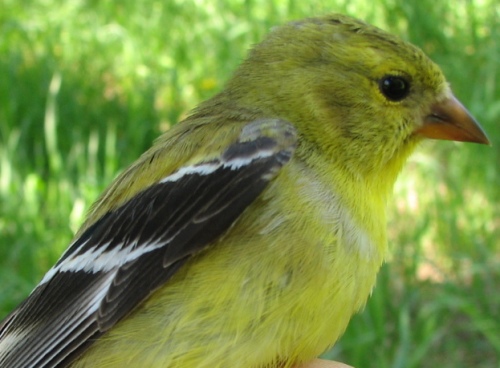
A typical SY female in alternate plumage.
Photo by Barbara Frei, McGill Bird Observatory (QC), May 2008
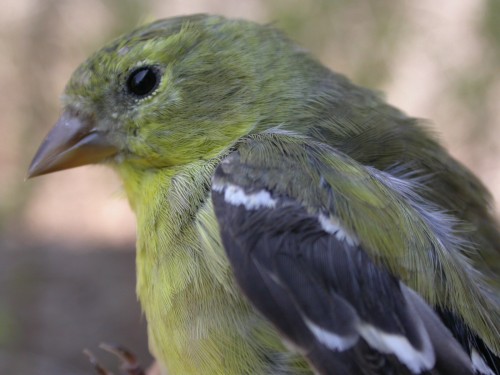
A typically dull SY female in mostly basic plumage.
Photo by Marcel Gahbauer, McGill Bird Observatory (QC), May 2006
The entire wing has a brownish cast, but the primary coverts are paler
than the greater coverts, showing a typical second-year molt limit. Molt limits are also often visible among the inner greater coverts.
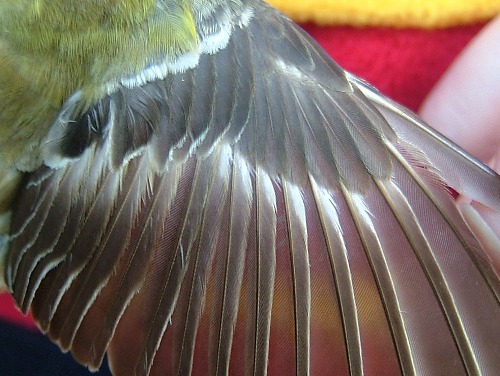
A particularly worn SY female, with a single contrastingly fresh alternate inner greater covert.
Note that otherwise the wing appears uniform and could be confused with an ASY female,
but it is overall much paler and more worn.
Photo by Peter Pyle, Howell Woods (NC), May 2006
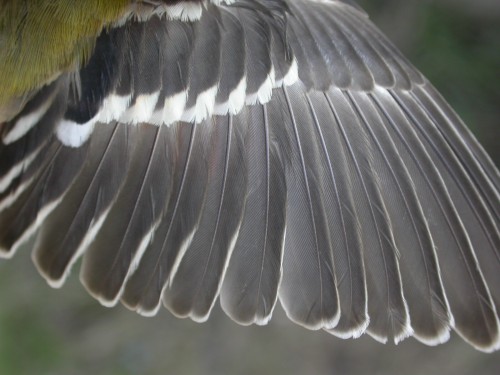
A more typical SY female, dull brown across the wing, again with one contrastingly fresh
and dark alternate greater covert. Since ASY females can also replace up to two inner
greater coverts during the prealternate molt and this wing otherwise looks fairly uniform,
it could be aged as SY only based on a distinctly juvenile tail.
Photo by Marcel Gahbauer, McGill Bird Observatory (QC), May 2006
SY females are usually most readily recognized by their tail, considering that the appearance of the wing can sometimes be difficult to distinguish from ASY females. SY females have a dull brownish tail, with small to moderate and generally indistinct whitish patches. In some cases, the rectrices are also distinctly narrower and more tapered than those of ASY goldfinches, but there are many intermediates and shape is generally less reliable than pattern.
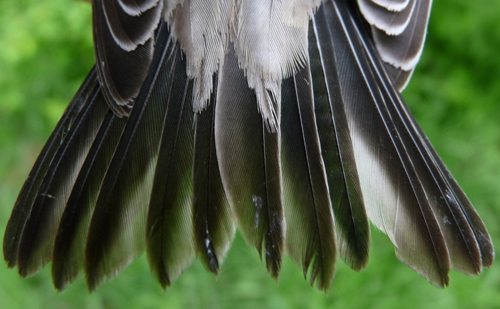
A typical SY female tail, with dull and relatively narrow rectrices showing only a moderate
and gradual contrast with the paler patches, that do not extend quite to the tip of the tail.
Photo by Marcel Gahbauer, McGill Bird Observatory (QC), May 2010
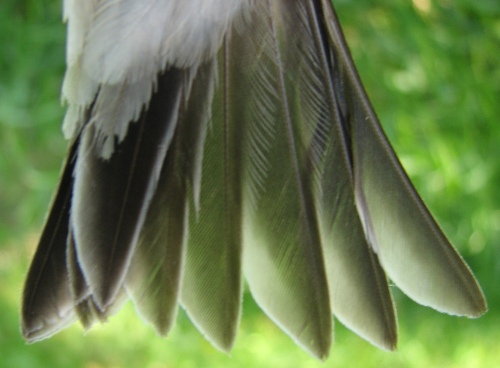
An example of an SY female with even less distinctly defined pale patches on the tail.
Photo by Barbara Frei, McGill Bird Observatory (QC), May 2008

An SY female with moderately large pale patches on the outer rectrices, but with a very
pale tail overall, and with the outer rectrices quite narrow and tapered.
Photo by Marcel Gahbauer, McGill Bird Observatory (QC), May 2006
RETURN TO AGE/SEX
OVERVIEW
|
JUL - DEC: after-hatch-year
male |
AHY males are generally recognizable by their black wings, but as plumage can vary considerably among individuals, it is best to also consider the wing and tail before determining age and sex.
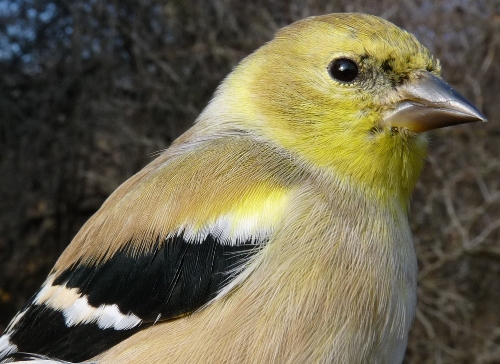
A distinct AHY male, with solid black wings, some retained black flecks on the forehead,
and yellow on the head and lesser coverts.
Photo by Marcel Gahbauer, McGill Bird Observatory (QC), November 2009
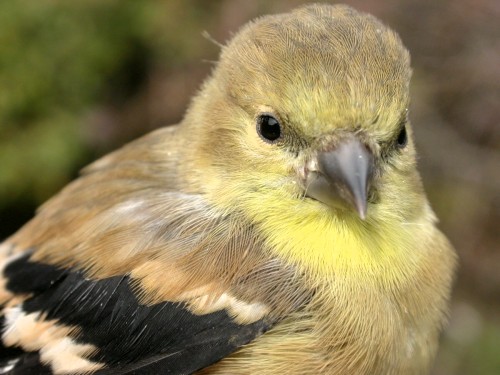
A more typical AHY male, again with distinctly black wings, but with less yellow plumage,
and lacking any black feathers on the crown, and therefore differing more subtly
from other age/sex classes.
Photo by Marcel Gahbauer, McGill Bird Observatory (QC), November 2004
AHY males have a largely black wing. Relatively often there is a contrast between the black greater coverts and somewhat paler primary coverts; although this is not a molt limit, it can create a pattern relatively similar to that on HY males that have replaced all greater coverts and caution is required (check tail and/or skull pneumatization to confirm age of these individuals).
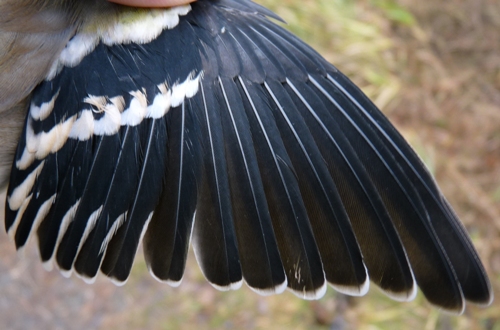
An AHY male with a particularly sharp contrast between the greater coverts and primary
coverts, but note the solid black of the rest of the wing, and the hint of yellow just
barely visible in the lesser and median coverts.
Photo by Marcel Gahbauer, McGill Bird Observatory (QC), November 2009
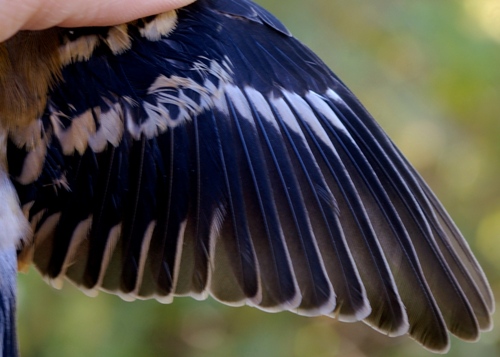
A somewhat dark photo, but note that again there is a bit of a contrast with paler primary
coverts; in this case there are also distinct white patches on the primaries below the
primary coverts.
Photo by James Junda, McGill Bird Observatory (QC), October 2008
Considering that overall plumage and the appearance of the wing can overlap considerably between HY and AHY males (especially late in fall), the tail often provides the best indicator of age for goldfinches. AHY males have black tails with extensive and sharply defined white patches, and although there are many intermediates with respect to shape, rectrices that are broad and rounded also are typical of AHY goldfinches.
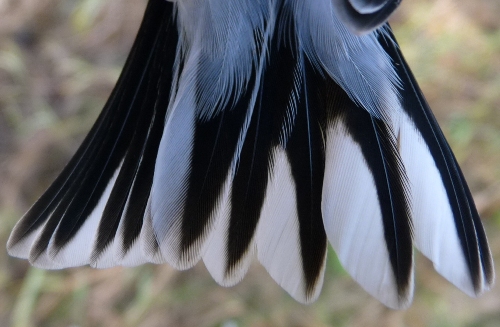
A distinct AHY male tail, with broad and rounded rectrices that are black and have distinct
large white patches.
Photo by Marcel Gahbauer, McGill Bird Observatory (QC), November 2009
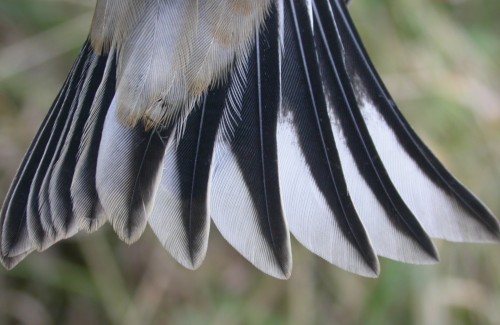
Another example, showing a somewhat more intermediate tail shape, and with the white
patches graying just slightly toward the tip, but with the tail overall showing a sharper
black/white contrast than typical on HY goldfinches.
Photo by Marcel Gahbauer, McGill Bird Observatory (QC), October 2005
RETURN TO AGE/SEX
OVERVIEW
|
JUL - DEC: after-hatch-year
female |
In fall, after-hatch-year females may show
nearly as much contrast between the wing and back as males, but the
black of the wing is generally a bit more dull, and there tends to be
less yellow on the throat, head, and wings.
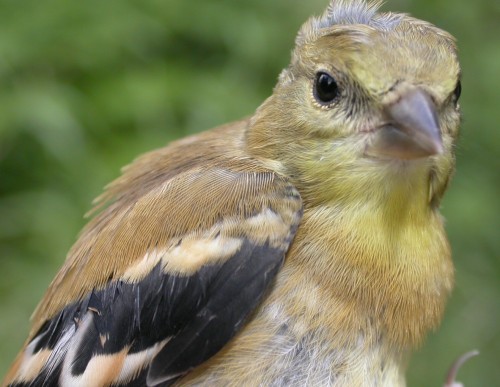
An AHY female in basic plumage, with a fairly dark wing, but overall slightly duller
than most AHY males.
Photo by Marcel Gahbauer, McGill Bird Observatory (QC), September 2005
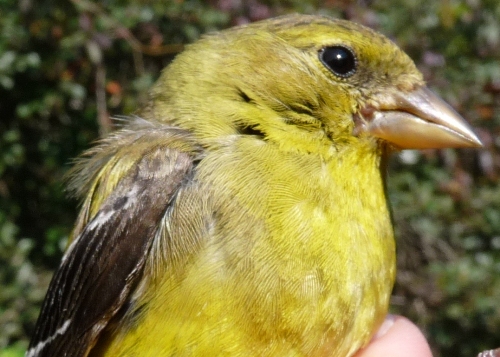
An AHY female still in alternate plumage, mostly yellow but lacking the black cap of males,
and with a dark brown rather than black wing.
Photo by Marcel Gahbauer, McGill Bird Observatory (QC), September 2009
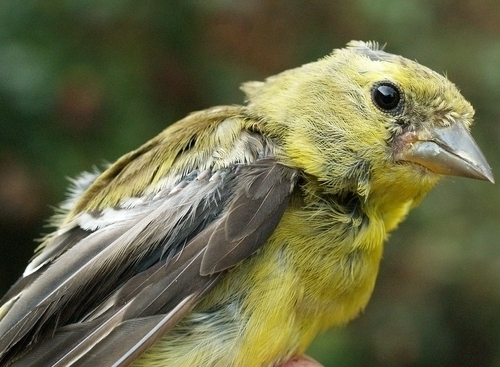
An AHY female in the early phases of prebasic molt, still with a fair amount of yellow.
Photo by Simon Duval, McGill Bird Observatory (QC), September 2010
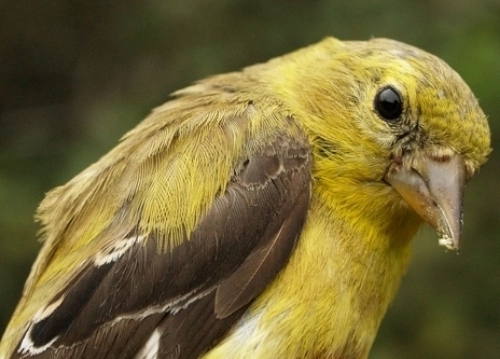
Another AHY female beginning its prebasic molt.
Photo by Simon Duval, McGill Bird Observatory (QC), September 2010
AHY females have a uniformly dark wing, but not quite as black as AHY males. As with males, the primary coverts sometimes appear slightly paler, though the contrast is usually more subtle since the wing is duller to begin with.
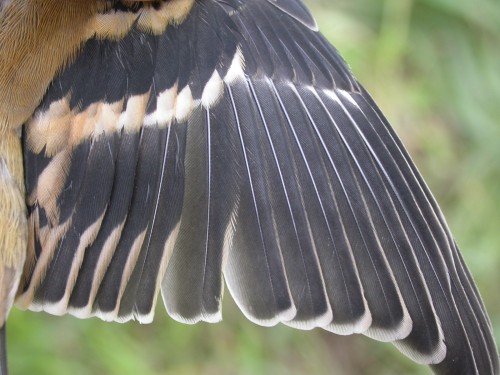
A typical AHY female wing, with a relatively uniform dark but not quite black appearance.
Photo by Marcel Gahbauer, McGill Bird Observatory (QC), September 2005
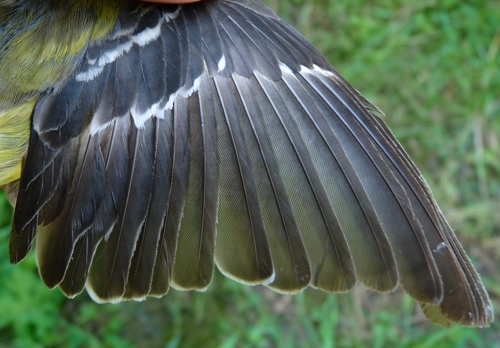
An AHY female prior to the prebasic molt, showing a fair amount of wear. Since there are
no apparent molt limits and none of the feathers are particularly faded, this is most
likely an ASY female (compare with SY females).
Photo by Marcel Gahbauer, McGill Bird Observatory (QC), September 2009
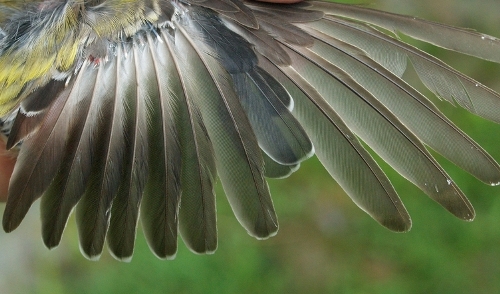
An AHY female in the early phase of prebasic molt; as HY goldfinches do not replace
any primaries, any goldfinch molting them systematically can safely be aged as AHY.
Photo by Simon Duval, McGill Bird Observatory (QC), September 2010
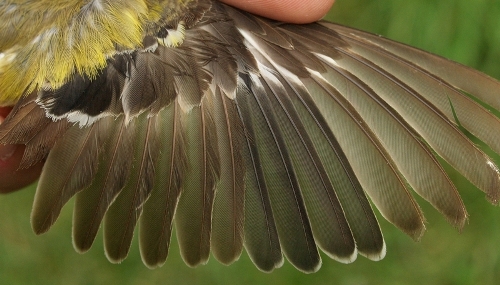
As in the previous example, the prebasic molt has begun; in this case there is a much more
distinct contrast between the fresh primaries and the much paler retained feathers. The
amount of wear on the juvenile coverts, in combination with the paleness of the wing
suggest that this is an SY female.
Photo by Simon Duval, McGill Bird Observatory (QC), September 2010
As with males, the tail can be helpful in determing age of females. AHY females have dark (but not black) rectrices, with moderately large white or whitish patches that usually fade to gray toward the tip. Although there are many intermediates with respect to shape, rectrices that are broad and rounded are indicative of AHY goldfinches.
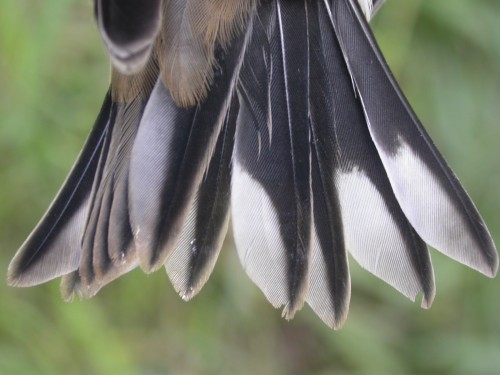
A typical AHY female tail, with dark feathers contrasting with moderately large whitish
patches that fade to gray near the tip of the tail. Note that rectrix shape is relatively
intermediate, and therefore not helpful in determining age.
Photo by Marcel Gahbauer, McGill Bird Observatory (QC), September 2005
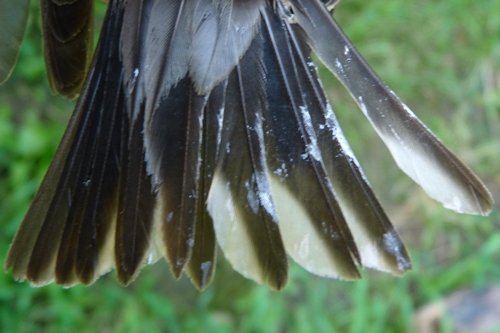
A more worn tail, corresponding with the alternate plumage AHY female in previous sections.
The relatively distinct whitish patches and decent condition of the tail after nearly a full
year suggest that it is likely an ASY female.
Photo by Marcel Gahbauer, McGill Bird Observatory (QC), September 2009
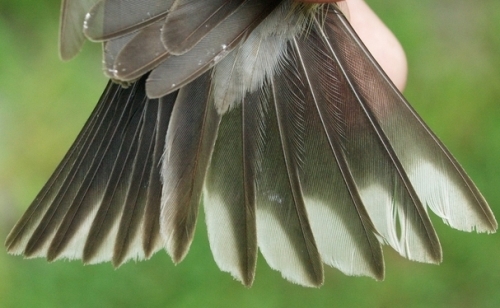
This photo corresponds with the third body and wing photos in previous sections, and it
appears that prebasic molt of the tail has not yet begun. Again, considering the relatively
broad and rounded shape and good condition of these rectrices after a full year, plus
the fairly distinct white patches, this is very likely an ASY female.
Photo by Simon Duval, McGill Bird Observatory (QC), September 2010
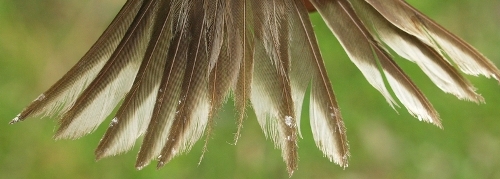
This photo corresponds with the final body and wing photos in previous sections. Compare
with the previous photo and note how much paler this tail is, and in particular how much
more extreme the amount of wear is, especially on the central rectrices. Combined with
the wing, the evidence points to this being an SY female.
Photo by Simon Duval, McGill Bird Observatory (QC), September 2010
RETURN TO AGE/SEX
OVERVIEW
|
JUL - DEC: hatch-year
male |
HY goldfinches generally have a brownish appearance, with males having
somewhat darker wings than females, although many intermediates need to
be looked at closely to determine sex correctly.
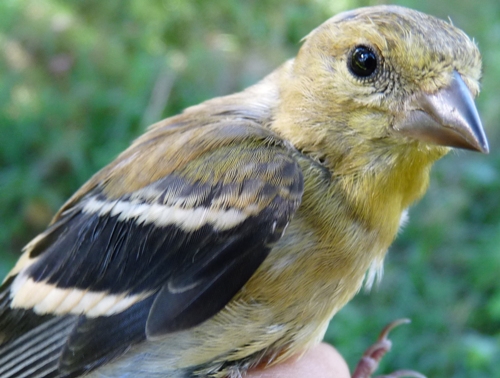
A typical HY male, largely brown, but with dark wings and a hint of yellow on the throat.
Photo by Marcel Gahbauer, McGill Bird Observatory (QC), September 2009
Hatch-year males have a dark brown to blackish wing, with the
primary coverts usually somewhat paler than the greater coverts.
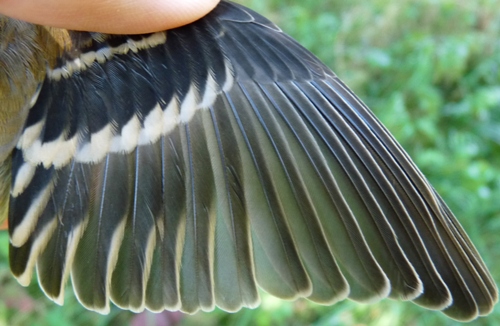
A typical HY male wing, with dark greater coverts contrasting somewhat with more
brownish primary coverts, primaries, and secondaries.
Photo by Marcel Gahbauer, McGill Bird Observatory (QC), September 2009
The tail of HY males is most similar to that of AHY females, in that it is dark but not black, and there typically are moderately large and reasonably distinct whitish patches on the outer rectrices. On average, HY goldfinches have somewhat narrower and more tapered rectrices than AHY goldfinches, but there are many intermediates where shape is not helpful for ageing.
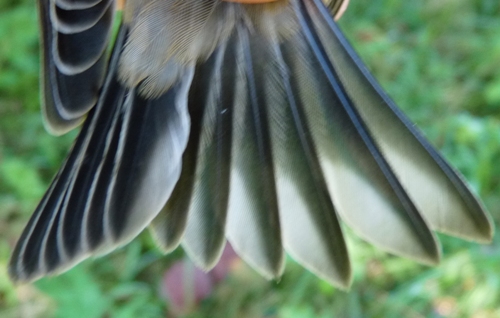
An HY male showing rectrices of an intermediate shape, and with colouration that is paler
than that of AHY males, but darker than most HY females. However, the overall appearance
of this tail is note reliably distinguishable from patterns seen on AHY females, therefore
wing and/or skull pneumatization are required to confirm age and sex.
Photo by Marcel Gahbauer, McGill Bird Observatory (QC), September 2009
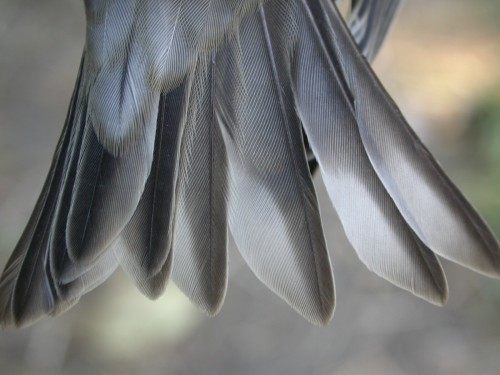
This tail shows the more narrow and tapered shape indicative of HY goldfinches. The
rectrices are pale enough to possibly suggest a female, though the whitish patches are
fairly large; in such a case sex needs to be assessed by wing and/or overall plumage.
Photo by Marcel Gahbauer, McGill Bird Observatory (QC), August 2005
RETURN TO AGE/SEX
OVERVIEW
|
JUL - DEC: hatch-year
female |
HY
goldfinches generally have a brownish appearance, with females having
somewhat lighter wings than males, although many intermediates need to
be looked at closely to determine sex correctly.
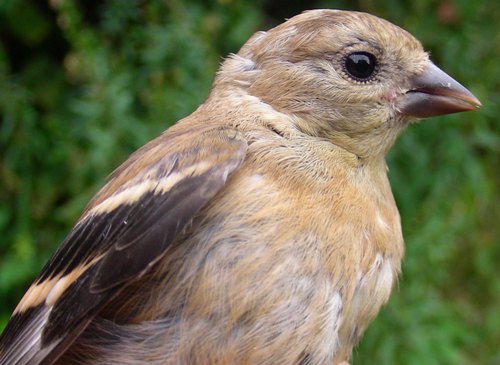
A typical HY female, largely brownish, without any yellow plumage.
Photo by Marcel Gahbauer, McGill Bird Observatory (QC), September 2008
Hatch-year females have a brown to dark brown wing,
with the primary coverts usually distinctly paler than the greater
coverts.
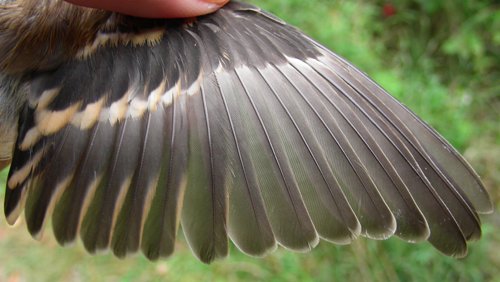
An HY female wing, relatively dull brown throughout, with only the somewhat darker
formative greater coverts providing a contrast.
Photo by Marcel Gahbauer, McGill Bird Observatory (QC), September 2008
HY female goldfinches have particularly pale rectrices compared to other age/sex classes, and with more restricted whitish patches, making the tail a relatively good indicator for them. As with males, some HY females also have rather narrow and tapered rectrices.
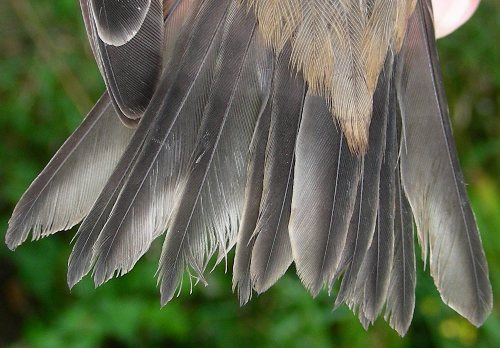
An HY female with particularly limited pale patches on the rectrices.
Photo by Marcel Gahbauer, McGill Bird Observatory (QC), September 2008
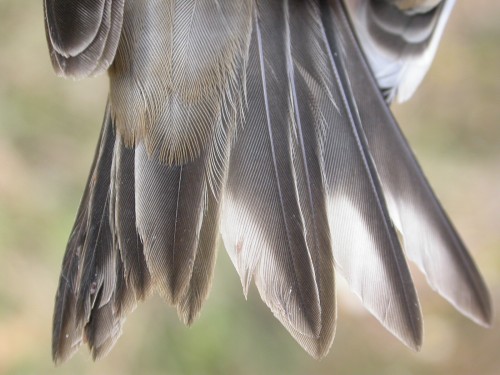
A somewhat more typical HY female, with whitish patches on the outer rectrices, but note
that they fade to gray toward the tips, the rectrices are relatively pale gray-brown, and
they are also quite narrow and pointed.
Photo by Marcel Gahbauer, McGill Bird Observatory (QC), August 2005
RETURN TO AGE/SEX
OVERVIEW
|






















































































